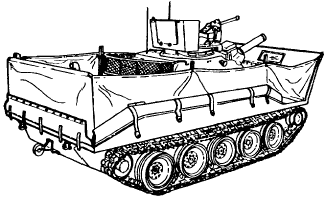| GENERAL DATA |
|---|
| | M551, M551A1 |
|---|
| Alternative Designations | AR/AAV, General Sheridan, Sheridan |
|---|
| Country of Origin | USA |
|---|
| Role | Armored reconnaissance, airborne anti-tank vehicle |
|---|
| Date Of Introduction | M551: 1967. M551A1: 1975 |
|---|
| Crew | 4 (commander, driver, gunner, loader) |
|---|
| Combat Weight | M551: 16.7 tons (15.2 mt). M551A1: 18.0 tons (16.3 mt) |
|---|
| Ground Pressure | ? |
|---|
| Length, Overall |
20.67 ft (6.3 m) |
|---|
| Width, Overall |
9.25 ft (2.82 m) |
|---|
| Height, Overall |
9.68 ft (2.95 m) |
|---|
| Ground Clearance | 19 in (483 mm) |
|---|
| PERFORMANCE |
|---|
| | M551, M551A1 |
|---|
| Engine | 300 hp (224 kw) Detroit Diesel 6V53T six-cylinder diesel |
|---|
| Range | 373 miles (600 km) |
|---|
| Fuel Capacity | 158 gal (598 l). Diesel, JP-5/JP-8 Jet Fuel (emergency use only) |
|---|
| Road Speed | 43 mph (69 km/h) forward, 9 mph (14 km/h) reverse |
|---|
| Cross Country Speed | ? |
|---|
| Swim Speed | 3.8 mph (6.1 km/h) with flotation barrier |
|---|
| Fording Depth | ? |
|---|
| Grade | 60% |
|---|
| Trench Crossing | 7 ft (2.13 m) |
|---|
| Vertical Wall Climb | 2.75 ft (0.84 m) |
|---|
| PROTECTION |
|---|
| | M551, M551A1 |
|---|
| Armor | Steel turret, aluminum armor, aluminum hull |
|---|
| Applique Armor | Mine protective kit |
|---|
| Explosive Reactive Armor | N/A |
|---|
| Active Protective System | N/A |
|---|
| NBC Protection System | M8A3 Gas-Particulate Filter Unit |
|---|
| Smoke Equipment | Eight tube M176 (early) or M243 (later) smoke grenade launchers |
|---|
| ARMAMENT |
|---|
| M551, M551A1 |
|---|
| Type |
Mount |
Typical Ammo Load |
| 152mm M81 or M81E1 gun/launcher |
Turret; manual loading |
29 rounds:
10 Shillelagh guided missiles (HEAT).
19 conventional rounds (HE-T, HEAT-T-MP, canister). |
| 7.62mm M73, M219, or M240 machine gun |
Coaxial to main gun |
3,080 |
| .50 Cal M2HB machine gun |
Turret cupola |
1,000 |
|
| FIRE CONTROL |
|---|
| | M551, M551A1 |
|---|
| Fire Control System | M37 1x loader's periscope, M44 9x gunner's periscope,
M13A1C quadrant, azimuth indicator, M119 8x gunner's telescope (replaced by M127/M127A1 8x or 12x in later vehicles),
ANNSG-2B Tank Thermal Sight (M551A1). |
|---|
| Main Gun Stabilization | Yes |
|---|
| Rangefinder | ANNVG-1 Laser Range Finder (M551A1): 8x, 200 m to 4000 m range |
|---|
| Infrared Searchlight | Available |
|---|
NOTES
The M551 Sheridan is a light weight, full tracked, diesel powered armored reconnaissance/airborne assault vehicle.
It is capable of amphibious operation and can be transported and airdropped by heavy assault glider or cargo aircraft.
The Sheridan can be rigged for low-velocity airdrop from C-130 (42,000 lb max load) and C-141 aircraft (38,500 lb
max load), and for low-altitude parachute extraction (LAPE) airdrop from C-130 aircraft. Airdrop from the C-130 is
restricted to aircraft with a serial number 62-1784 or higher.
Armament consists of a 152mm gun/launcher mounted to a 360° rotatable turret and capable of firing either
conventional ammunition or Shillelagh direct-fire guided missiles; a 7.62mm machine gun mounted coaxially with the
gun/launcher; a .50 caliber machine gun mounted to the commander's power assist cupola, which is capable of 360°
rotation; and eight fixed-mount grenade launchers, four on each side of the turret.
Designed to replace the
M41 light tank and the
M56 90mm anti-tank gun. No longer in service. The Sheridan was supposed to be replaced by the canceled M8 AGS (armored gun system).
VISIBLE AND THERMAL RECOGNITION CUES
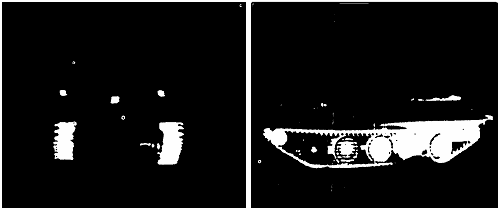
The M551 has a wide, low turret (front view) and a wedge shape (side view). Otherwise, its thermal signatures are
difficult to distinguish from those of a T-62 tank.
Characteristics visible from the front include:
- A wide, low turret, whose sides extend almost over the tracks, providing a unique front view.
- Warm tracks separated by a cool hull, visible as two red spots.
Characteristics visible from both sides include:
- A low profile: low hull and a small, low, flat turret.
- A wedge-like shape, with the wedge pointing to the vehicle's front and visible between 800 and 1,200 meters.
- A high side decking.
- Warm, slack tracks and (at short ranges) five evenly spaced road wheels.
- A short gun tube that can be seen when the gun has recently fired.
- A rear engine and rear exhaust, whose plume may be directed upward or rearward.
VARIANTS
- XM551
- 1965. Limited production prototype.
- M551 (NSN 2350-00-873-5408)
- 1967. "Armored Reconnaissance/Airborne Assault Vehicle, Full-Tracked 152MM Gun/Launcher".
Original production model.
- "Two-box" M551
- 1969. A special configuration M551 which did not
include a complete Shillelagh guidance and control system. After removal of missile system components, a special
purpose kit was installed in these vehicles to provide turret and weapon stabilization using the remaining two
missile system components (power supply and rate sensor). Stowage brackets for .50 caliber and 7.62mm ammo boxes
replaced components removed from the turret missile system. Ammunition racks were adjusted to hold conventional
ammunition rounds.
- M551A1 (NSN 2350-00-140-5151)
- 1975-1977. The M551 became the M551A1 when equipped with
the ANNVG-1 Laser Range Finder (LRF) and ANNSG-2B Tank Thermal Sight (TTS).
- M551 NTC (NSN 2350-01-115-1579)
- 1981. The hull, suspension, and miscellaneous hull components of the
M551A1 and M551 NTC are identical. The M551 became the M551 NTC when configured for use in training at the National Training Center (NTC) in Fort Irwin,
California and the Joint Readiness Training Center (JRTC) in Fort Chaffee, Arkansas.
HISTORY
- June 1959: Development of the Shillelagh missile system began.
- 17 September 1959: Armored Reconnaissance/Airborne Assault Vehicle approved for development.
- 4 August 1961: Secretary of the Army approved the name "General Sheridan" for the XM551 AR/AAV.
- 18 November 1965: XM551 type classified as Limited Production.
- 21 May 1966: M551 type classified as Standard A.
- 1967: Test firing program of 173 extended range missiles resulted in 90% hardware reliability (missile and
guidance & control system functioning properly), but only 57% overall system reliabilty (probability that
gunner, M551 vehicle, and missile system could hit a 7 1/2 ft by 7 1/2 ft target).
- June 1967: First tactical unit was equippled with the M551 (1st Battalion, 63d Armored at Fort Riley, Kansas).
- October 1967: M551 issued to the 1st Squadron, 17th Cavalry of the 82d Airborne Division at Fort Bragg, North Carolina.
- April 1968: First M551 issued outside continental U.S. (29th Infantry Brigade in Hawaii).
- January 1969: "Two-box" Sheridans with conventional ammunition deployed to Vietnam.
- 1978: 1,570 Sheridans in service.
- June 1978: Sheridan phasedown began.
- 1979-1980 (FY 1980): Phasedown of the Sheridans to a residual fleet of 140 vehicles was completed.
A total of 54 M551A1s remained in service at Fort Bragg with the 3-73 Armor Battalion of the 82d Airborne Division.
The Arkansas National Guard at Camp Robinson was using another 12 systems. The remaining systems were held in stock.
- 1980: Error-prone guidance and control components replaced by more modern hardware in approximately 137 Sheridans.
- 1981: Sheridans used as opposing forces vehicles at the National Training Center.
- February 1984: Sheridan removed from U.S. Army National Guard service. Arkansas was the last ARNG unit to have the vehicle.
- December 1989: M551A1 deployed during Operation Just Cause in Panama. The Sheridan was a very effective gun
system in the support of light infantry, providing direct fire support from overwatch positions and blowing entry
holes in buildings for infantry assaults.
- 1997: 3-73 Armor Battalion's M551A1 Sheridans deactivated.
152MM GUN/LAUNCHER
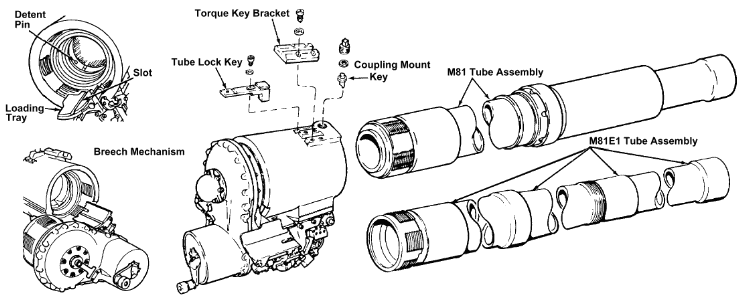
The 152mm gun/launcher is capable of firing conventional ammo or Shillelagh missiles; it is primarily used for
vehicle defense, but can also be used in an assault capacity.
The Shillelagh missile has a longitudinal key located just behind the warhead. The key fits into a slot (keyway) in
the gun tube and prevents the missile from rolling as it travels through the tube. The key also acts as a loading index to
orient the missile gyros.
Early tests showed that firing conventional (non-missile) ammunition resulted in cracks in the gun tube starting
in the missile keyway at the muzzle. Original gun tubes were limited to firing only 100 rounds of conventional
ammunition. The depth of the missile keyway was reduced so that it was no deeper than the gun tube rifling grooves.
Modifying the missile key and tube keyway raised the safe life of the tube to a minimum of 200 rounds.
M551 vehicles equipped with the M81 gun/launcher employ a CO2 bore and breech scavenging system to clear the
gun/launcher of residue and/or gases resulting from firing. Later vehicles are equipped with the M81E1
gun/launcher, which employs a compressed air closed breech scavenging system for the same purpose.
The driver's hatch must be closed for all main gun firings. All crew members should be inside the
vehicle to prevent injury from muzzle blast of a conventional round or, in the case of a missile firing in
training with live warhead, to prevent possible fragment spray from early ground impacts.
TURRET MISSILE SYSTEM
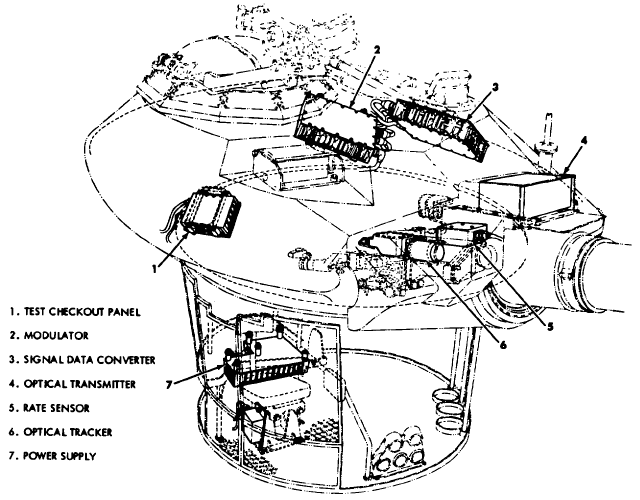
The guidance and control system controls the missile during its flight from the gun/launcher to the target.
- Test Checkout Panel. This panel is used to initiate operational tests of the guidance and control system.
- Modulator. The modulator takes the signals from the signal data converter and converts them to high
current output to operate the transmitter.
- Signal Data Converter. The SDC is the command center of the guidance and control system. The SDC
combines signal output from the tracker with turret traverse and gun/launcher elevation rate information from the
rate sensor to compute corrections necessary to keep the missile on the line of sight. The correction signals are
then sent to the modulator as missile command signals.
- Optical Transmitter. The transmitter converts the high current electrical signals into infrared signals.
A narrow infrared beam, containing guidance command signals is then sent to the missile.
- Rate Sensor. The rate sensor produces signals corresponding to the rate of turret traverse, gun
elevation or depression. These signals are sent to the signal data converter to assist in making it possible for
the missile to follow a moving line of sight as the gunner is tracking a moving target.
- Optical Tracker. This unit is the "eye" of the system and is mounted just above, and aligned
with, the gunner's telescope. During a missile firing, it tracks the in-flight missile, determines how far it has
moved from the line of sight, then sends the information to the signal data converter (SDC).
- Power Supply. Provides power for the missile guidance and control system.
Stop the vehicle before launching a missile - this will give you the stable position needed to guide the missile
on target.
Missiles should not be fired over friendly troops in training due to the hazard from early ground impacts.
Gunner launching electrically: Press palm switch and establish target in center crosspoint of missile reticle.
Continue tracking target and press trigger. It will take a second or so before missile launches. DON'T release
trigger until missile launches. Continue tracking target until missile impact. DON'T try to track missile; if you do,
you will never hit the target.
Gunner launching manually: With target in center crosspoint of missile reticle, press firing button on elevation
handwheel. It'll take a second or so before the missile fires. Keep tracking the target with manual controls, keeping
the target in the center crosspoint of the reticle until missile impact. DON'T track missile.
The commander can also launch the missile by pressing his palm switch (this electrically overrides the gunner's
control) and then pressing the trigger. However, since the commander cannot accurately track the target, he should
not launch missiles except in extreme cases.
152MM CONVENTIONAL AMMUNITION
Conventional (non-missile) 152mm ammunition is issued as fixed (complete and permanently assembled) rounds.
The propelling charge is not adjustable.
A complete round of ammunition consists of all components required to fire the weapon once. These
components consist of a primed cartridge case containing the propelling charge and a projectile, fuzed
or unfuzed depending on type. The complete round is loaded into the weapon as a unit.
DO NOT chamber 152mm ammo until ready to fire, this ammo has a highly flammable nonmetallic cartridge case. Fire or
remove ammo within 5 minutes of chambering. Under no circumstances fire a HEAT-T-MP or HE-T round that has been
allowed to remain in a hot gun/launcher more than 5 minutes.
Firing temperature limits for conventional rounds are +125°F to -40°F for all rounds except
HE-T cartridge M657A2, which has a lower limit of +40°F.
152mm conventional ammunition.
| Model |
Type |
Length |
Weight |
Load |
Fuze |
| M409, M409A1 |
HEAT-T-MP |
26.9 in (683 mm) |
49.8 lb (22.6 kg) |
Comp B |
M539 |
| M411 |
Training |
26.7 in (678 mm) |
48.8 lb (22.1 kg) |
Inert projectile, tracer, spotting charge |
M557 |
| M411A1 |
Training |
26.7 in (678 mm) |
49.8 lb (22.6 kg) |
Inert projectile, tracer |
N/A |
| M411A2, M411A3 |
Training |
26.9 in (683 mm) |
49.8 lb (22.6 kg) |
Inert projectile, tracer |
N/A |
| M596 |
Training |
26.9 in (683 mm) |
49.8 lb (22.6 kg) |
Inert |
N/A |
| M625, M625A1 |
Anti-personnel |
19.2 in (488 mm) |
48.5 lb (22 kg) |
Flechette |
N/A |
| M657 |
HE-T |
24.6 in (625 mm) |
51.5 lb (23.4 kg) |
TNT |
M720 |
M409 (XM409E5), M409A1 (XM409E6) High Explosive Anti-Tank with Tracer, Multipurpose (HEAT-T-MP)

Anti-armor, anti-personnel, anti-materiel. M409: Black with yellow markings. M409A1: Black with white markings and yellow band.
Super-quick, PIBD (point initiating, base detonating) M539 (XM539E4) fuze.
High explosive, shaped charge, Comp B, warhead.
M411 (XM411E3) Target Practice with Tracer (TP-T), Fused
Training. Blue with white markings and one yellow band. Super-quick, PD (point detonating) M557 fuze.
Contains tracer and spotting charge.
M411A1 (XM411E4), M411A2 (XM411E5), M411A3 (XM411E7) Target Practice with Tracer (TP-T), Un-fuzed
Training. Blue with white markings. Inert projectile with tracer.
M596 Dummy
Drill (handling). Blue with white markings. Un-fuzed. A one piece inert round made of cast aluminum.
M625 (XM625), M625A1 Canister
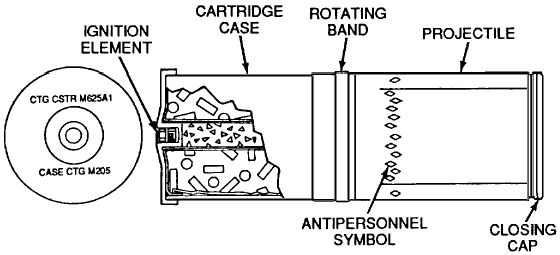
Anti-personnel (effective in dense foliage). Olive-drab with white markings, white diamonds and yellow band. Un-fuzed.
The M625-series canister cartridges are loaded with flechettes that function directly in front of the gun muzzle.
Firing over friendly troops is prohibited. Approximately a 10.5-meter increase in arc width results for each
additional 50 meters of range:
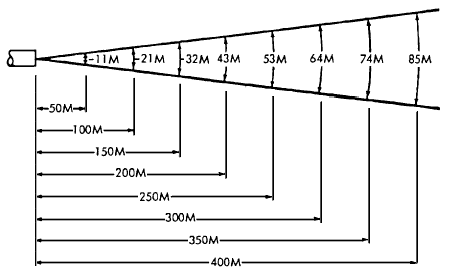
M657 (XM657E2), M657A2 High Explosive with Tracer (HE-T)
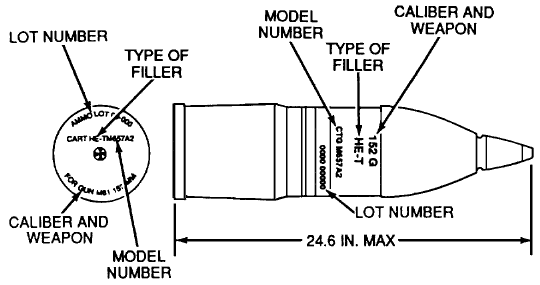
Anti-personnel, anti-materiel. Olive-drab with yellow markings. Super-quick, PD (point detonating) M720 or M720A1 fuze.
Never fire the HE-T cartridge over friendly troops or through brush or other obstructions close to vehicle. The fuze
on this round is very sensitive and could cause premature detonation.
152MM MISSILE AMMUNITION
88,194 Shillelagh missiles were produced from 1966 to 1971. Unit cost of the missiles varied from $1,938 to $4,052.
The Shillelagh missile has a longitudinal key located just behind the warhead. The key fits into a slot (keyway) in
the gun tube and prevents the missile from rolling as it travels through the tube. The key also acts as a loading
index to orient the missile gyros.
Firing temperature limits for the Shillelagh missile are +145°F to -25°F.
152mm missile ammunition.
| Model |
Type |
Length |
Weight |
Max Range |
| MGM-51A |
HEAT |
43.7 in (1,110 mm) |
59.11 lb (26.8 kg) |
2,187 yd (2,000 m) |
| MGM-51B, MGM-51C |
HEAT |
45.4 in (1,153 mm) |
61.28 lb (27.8 kg) |
3,281 yd (3,000 m) |
| MTM-51A |
Training |
? |
? |
N/A |
| MTM-51B, MTM-51C |
Training |
? |
? |
N/A |
MGM-51 Surface Attack Guided Missile ("Shillelagh")

The Sheridan's primary anti-armor ammunition. HEAT (high explosive anti-tank) warhead.
MGM-51A (XMGM-51A): Basic midrange missile (2,000 m). Replaced by the MGM-51B.
Type Classification: Standard A. Type Classification Date: 21-MAY-1966.
MGM-51B (XMGM-51B): Extended range missile (3,000 m). Product improvement of the MGM-51A involving minimum
changes (mainly a longer-burning gas generator). These changes did not affect accuracy and kill probability at ranges
less than 2,000 meters. Engineering refinements kept the production cost of the long-range missile about the same as
the shorter range MGM-51A missile. Replaced by the MGM-51C. Type Classification: Standard A. Type Classification Date: 20-APR-1967.
MGM-51C: This "shallow key" missile has a shorter longitudinal key. Existing MGM-51B missiles
converted to MGM-51C configuration. Type Classification: Standard A. Type Classification Date: JAN-1968.
MGM-51C-1: An optical filter is installed in the missile's tungsten beacon (infrared light source) to avoid
distracting gunners during night firings. All existing MGM-51C missiles converted to this configuration (1971-1974).
MTM-51 Practice Missile
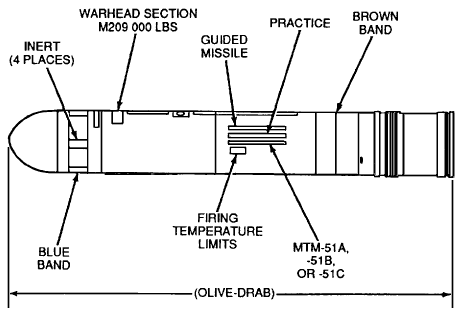
Dummy missiles simulate the Shillelagh missile in size, weight, center of gravity, and "feel."
The dummy missile is completely inert and contains no explosives. It is provided as a "drill" round for
training in loading the Shillelagh missile into the gun/launcher.
MTM-51A (XMTM-51A): Training round for the MGM-51A midrange missile.
MTM-51B (XMTM-51B): Training round for the MGM-51B extended range missile.
MTM-51C: Training round for the MGM-51C extended range "shallow key" missile.
DRIVETRAIN
The drivetrain consists of the powerplant, driveshafts, drive sprockets, and suspension system that transfer the
power produced by the powerplant to the tracks and drives the vehicle.
The powerplant consists of the engine and transmission. The powerplant is removed from the vehicle as one unit and
may be operated outside of the vehicle with a minimum of special equipment.
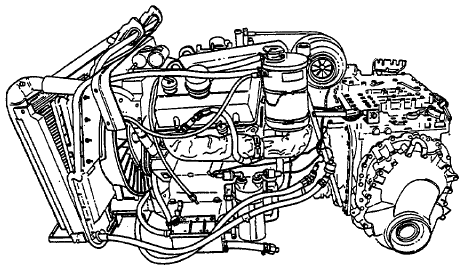
The engine is a Detroit Diesel Corporation Series V53, model 6V53, liquid-cooled, diesel engine. Any of three
different engine models can power the Sheridan. Model 5063-5395 is the old cast iron engine block, model 5063-5398
is the aluminum engine block, and model 5063-539F is the new cast iron engine block. All the engine models are
two-cycle, fuel-injected, V-type, liquid-cooled, six-cylinder, diesel engines with wet cylinder liners. The engine
has a maximum governed full-load speed of 2,800 rpm, an idle speed of 600 to 700 rpm, and a maximum no-load speed of
2,950 to 2,990 rpm.
The transmission is a Detroit Diesel Corporation X-drive model, which delivers power to left and right drive shafts
to drive the vehicle. The XTG 250-1A has full-power shifting under load, through four forward gears, one neutral, and
two reverse gears. It also functions as the steering and braking mechanism, during either land or water operations,
for the vehicle.
The suspension system consists of the sprocket drive assemblies, roadwheels, idler assemblies, torsion bars, shock
absorbers, and track adjusters. The sprocket drive assemblies transfer power from the transmission to the track. Five
roadwheels on each side support the tracks. The roadwheels are connected by the roadwheel arms to the torsion bars
which act as springs for the roadwheels. The roadwheel arms act as pivots between the roadwheels and the torsion bars.
The idler wheels and track adjusters provide a constant tension for the track. Shock absorbers at the front and back
of the vehicle handle differences in the terrain over which the vehicle operates.
FLOTATION SYSTEM
The flotation system consists of the flotation barrier, surfboard assembly, and the front and rear bilge pumps. The
flotation barrier and surfboard assembly are used during amphibious operations to keep the vehicle afloat. The rear
and front bilge pumps and outlets are used to remove water that enters the vehicle during amphibious operations.
MINE PROTECTIVE KIT
The mine protective kit consists of an armor steel plate and aluminum spacer plate for the hull bottom, two armor
steel side plates, and attaching hardware. The kit is used only when operating conditions require installation.
More M551 Art - Click on image sample to see full size image.
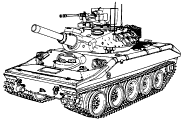
M551/M551A1
700x460, 41K, GIF
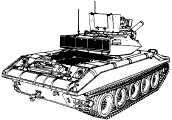
M551/M551A1
665x465, 46K, GIF
M551 Photos - Click on image sample to see full size image.
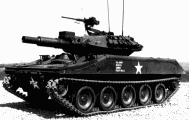
XM551
U.S. Department of Defense Photo
1260x800, 175K, B/W, JPEG
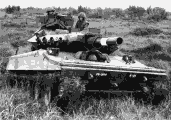
M551 and crew of 3d Squadron, 4th Cavalry
U.S. Department of Defense Photo
986x690, 176K, B/W, JPEG
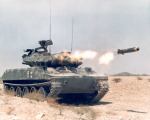
Sheridan firing Shillelagh missile
U.S. Army Photo
720x576, 41K, JPEG
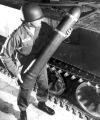
Shillelagh missile
U.S. Army Photo
576x720, 52K, B/W, JPEG
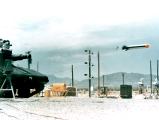
Shillelagh missile test firing
U.S. Army Photo
720x576, 39K, JPEG
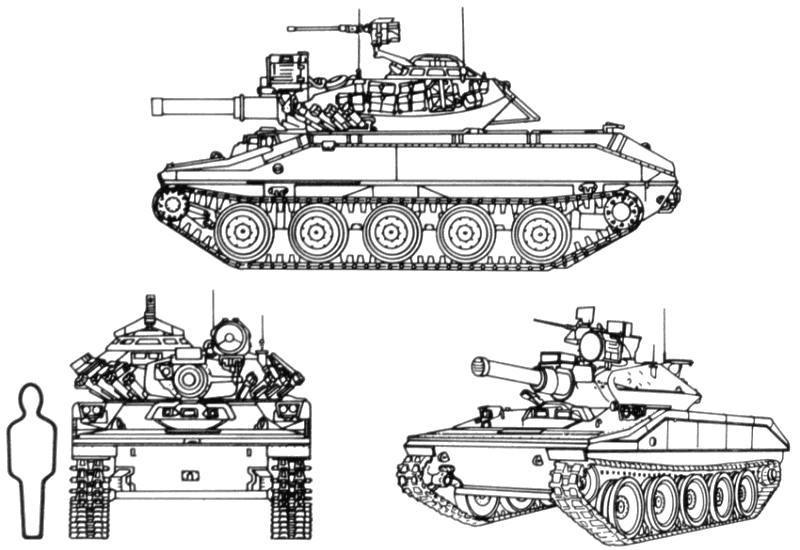
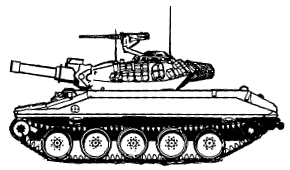
 The M551 has a wide, low turret (front view) and a wedge shape (side view). Otherwise, its thermal signatures are
difficult to distinguish from those of a T-62 tank.
The M551 has a wide, low turret (front view) and a wedge shape (side view). Otherwise, its thermal signatures are
difficult to distinguish from those of a T-62 tank.
 The 152mm gun/launcher is capable of firing conventional ammo or Shillelagh missiles; it is primarily used for
vehicle defense, but can also be used in an assault capacity.
The 152mm gun/launcher is capable of firing conventional ammo or Shillelagh missiles; it is primarily used for
vehicle defense, but can also be used in an assault capacity.
 The guidance and control system controls the missile during its flight from the gun/launcher to the target.
The guidance and control system controls the missile during its flight from the gun/launcher to the target.
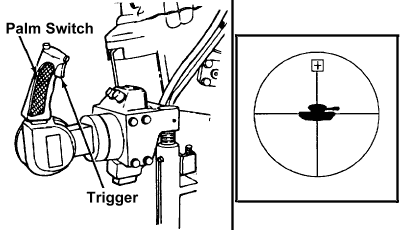
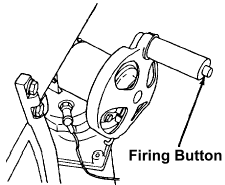
 Anti-armor, anti-personnel, anti-materiel. M409: Black with yellow markings. M409A1: Black with white markings and yellow band.
Super-quick, PIBD (point initiating, base detonating) M539 (XM539E4) fuze.
High explosive, shaped charge, Comp B, warhead.
Anti-armor, anti-personnel, anti-materiel. M409: Black with yellow markings. M409A1: Black with white markings and yellow band.
Super-quick, PIBD (point initiating, base detonating) M539 (XM539E4) fuze.
High explosive, shaped charge, Comp B, warhead.
 Anti-personnel (effective in dense foliage). Olive-drab with white markings, white diamonds and yellow band. Un-fuzed.
The M625-series canister cartridges are loaded with flechettes that function directly in front of the gun muzzle.
Firing over friendly troops is prohibited. Approximately a 10.5-meter increase in arc width results for each
additional 50 meters of range:
Anti-personnel (effective in dense foliage). Olive-drab with white markings, white diamonds and yellow band. Un-fuzed.
The M625-series canister cartridges are loaded with flechettes that function directly in front of the gun muzzle.
Firing over friendly troops is prohibited. Approximately a 10.5-meter increase in arc width results for each
additional 50 meters of range:

 Anti-personnel, anti-materiel. Olive-drab with yellow markings. Super-quick, PD (point detonating) M720 or M720A1 fuze.
Never fire the HE-T cartridge over friendly troops or through brush or other obstructions close to vehicle. The fuze
on this round is very sensitive and could cause premature detonation.
Anti-personnel, anti-materiel. Olive-drab with yellow markings. Super-quick, PD (point detonating) M720 or M720A1 fuze.
Never fire the HE-T cartridge over friendly troops or through brush or other obstructions close to vehicle. The fuze
on this round is very sensitive and could cause premature detonation.
 The Sheridan's primary anti-armor ammunition. HEAT (high explosive anti-tank) warhead.
The Sheridan's primary anti-armor ammunition. HEAT (high explosive anti-tank) warhead.
 Dummy missiles simulate the Shillelagh missile in size, weight, center of gravity, and "feel."
The dummy missile is completely inert and contains no explosives. It is provided as a "drill" round for
training in loading the Shillelagh missile into the gun/launcher.
Dummy missiles simulate the Shillelagh missile in size, weight, center of gravity, and "feel."
The dummy missile is completely inert and contains no explosives. It is provided as a "drill" round for
training in loading the Shillelagh missile into the gun/launcher.

